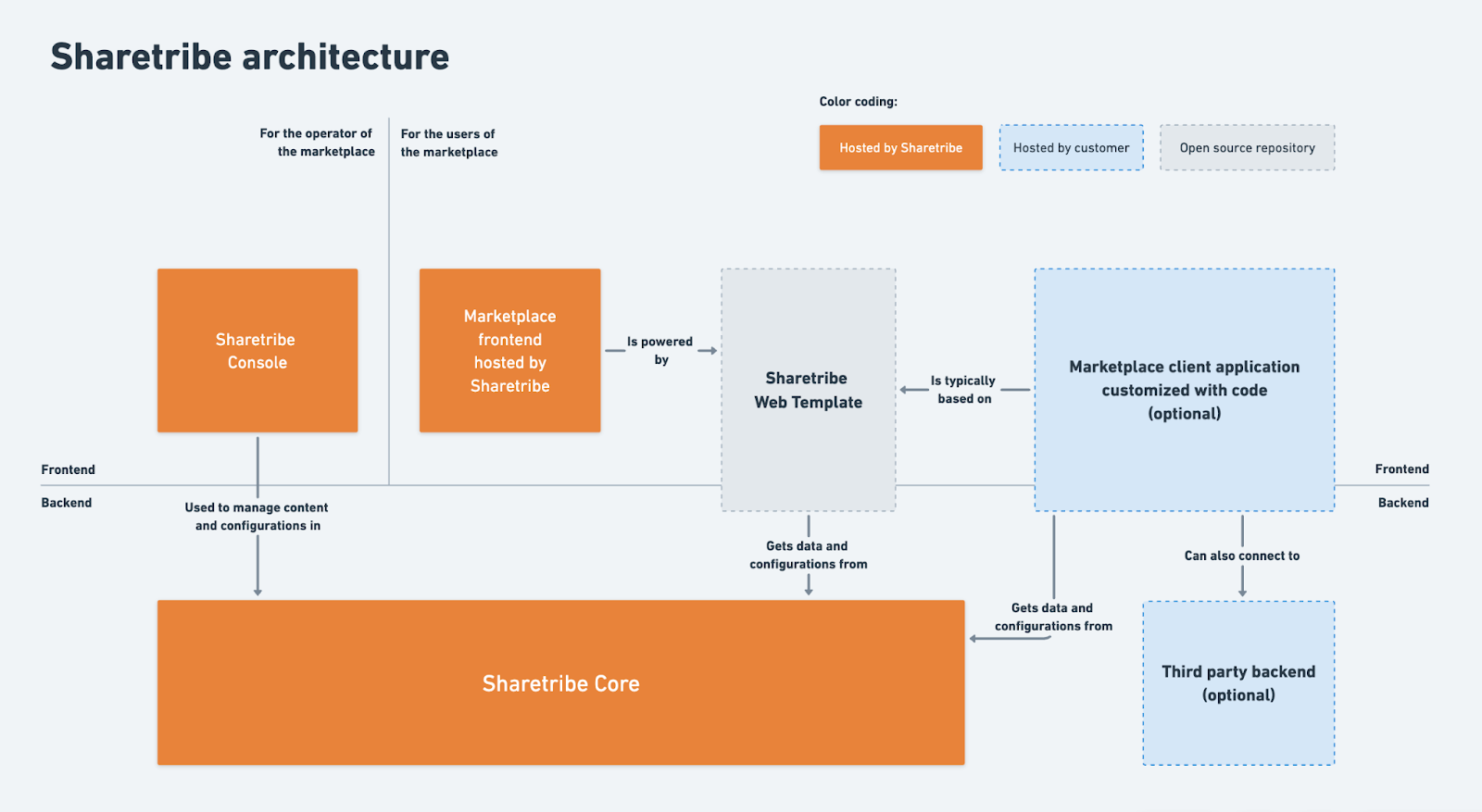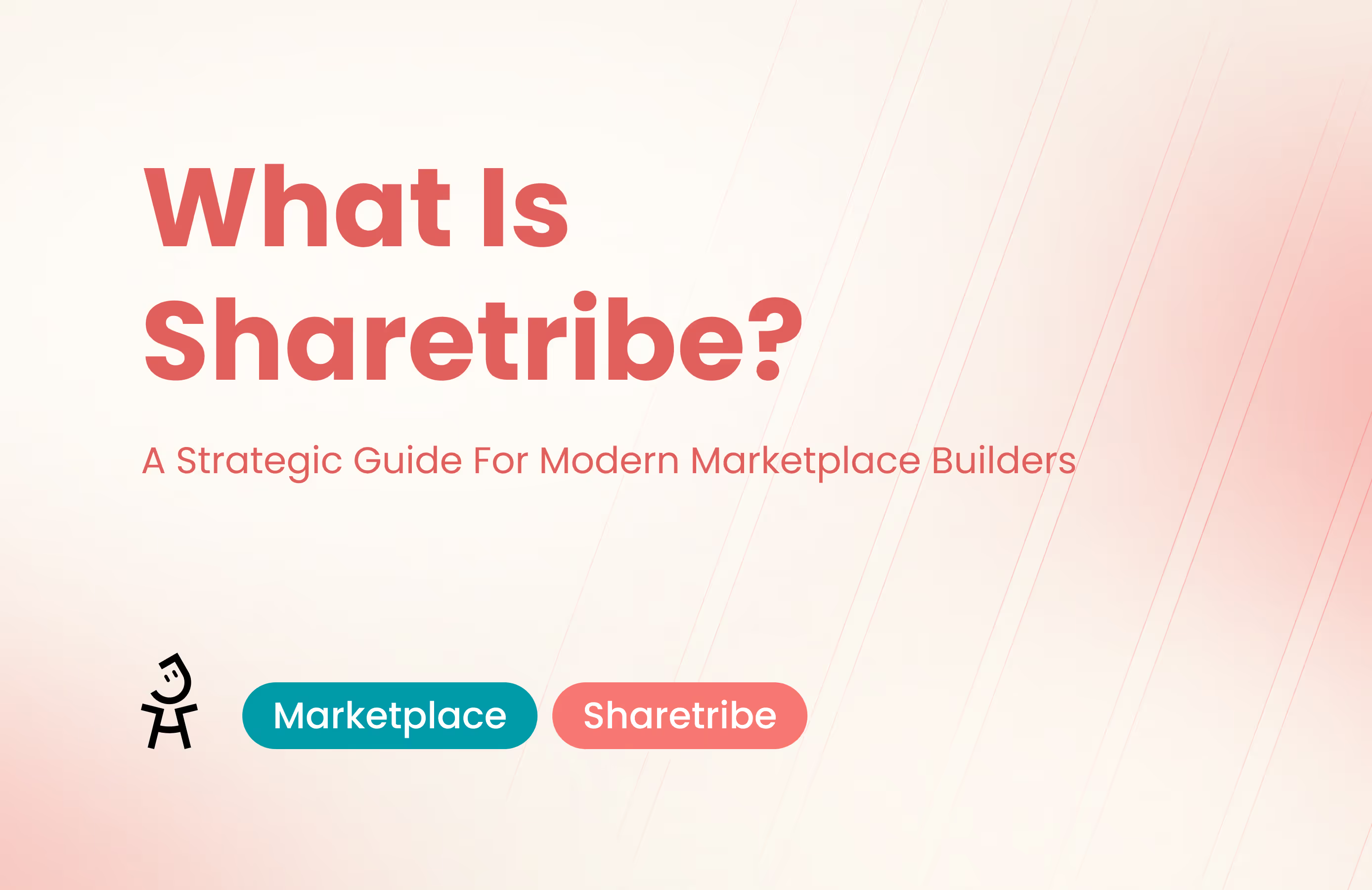Backend vs Frontend in Sharetribe Development: Understanding Sharetribe’s Architecture

Marketplaces often look simple on the surface, but the way they work behind the scenes is rarely straightforward. Most platforms bundle everything together, making it hard to customize the user experience or scale beyond the basics. Sharetribe takes a different path. Instead of locking you into a rigid system, it uses a modern headless marketplace architecture that separates how your marketplace functions from how it looks.
Once you understand this structure, the idea of backend vs frontend in Sharetribe development becomes much clearer. Sharetribe gives you a fully managed backend built specifically for marketplace logic and a flexible frontend layer you can shape freely. That combination is what makes the platform stand out: fast to launch, but powerful enough to grow and evolve with your product.
This guide breaks down Sharetribe’s technical architecture in a simple and intuitive way, helping you see how each layer works, why this separation matters, and how it opens the door to truly custom marketplace experiences.
And if you want to turn Sharetribe’s flexibility into a real competitive advantage, Journeyhorizon is here to help you unlock its full potential.
1. Backend vs Frontend in Sharetribe development: A beginner-friendly overview
1.1. What the frontend is
The frontend is the part of a marketplace that people actually see and use. When you visit a marketplace website, everything you click, read, or interact with belongs to the frontend. This includes the homepage, the search bar, the filters, the listing pages, the booking or checkout screens, the messaging area, and every visual design element on the site.
You can think of the frontend as the “face” of your marketplace. It runs in the user’s browser and shows information that it receives from the backend. Its job is to present data clearly and make the whole experience feel smooth and easy to use.
1.2. What the backend is
The backend is everything that happens behind the scenes. It is like the “engine” of your marketplace. While users never interact with it directly, it does all the important work that keeps the platform running. This includes storing data, managing user accounts, applying business rules, processing transactions, handling authentication, and making sure the marketplace stays secure and reliable.
Sharetribe’s backend manages all marketplace logic such as listings, bookings, payments, reviews, messages, notifications, and search performance. The best part is that Sharetribe fully manages and hosts the backend for you. This means you do not need to set up servers, build your own transaction system, or worry about maintenance and security. Everything is handled through Sharetribe’s APIs (Application Programming Interface), which your frontend can use to build the experience you want.

1.3. Why These Concepts Are Important in a Headless System
In a headless marketplace architecture, the frontend and backend are intentionally separated. They work independently but stay connected through APIs. This separation gives you complete freedom to design any user experience you want on the frontend, while Sharetribe takes care of all the heavy lifting on the backend such as data, transactions, and security.
Because of this setup, you can launch quickly with Sharetribe’s Web Template or build your own custom marketplace frontend without touching any backend infrastructure. Once you understand how this structure works, it becomes clear why Sharetribe is so flexible and why it supports both simple MVPs and long-term, fully customized marketplace products.
2. Sharetribe’s technical architecture explained
2.1. API-first marketplace development
Sharetribe is built as an API-first marketplace development platform. All interactions with marketplace data flow through APIs. The main one is the Sharetribe Marketplace API, which handles user authentication, listing data, searches, availability queries, and the creation and retrieval of transactions. The Integration API enables automation and connections to external systems through webhooks and event-based workflows.
This API-first foundation lets you build any kind of client interface - whether it is a website, a mobile app, or a progressive web app - and connect it directly to the Sharetribe backend. This removes technical limitations and gives teams full freedom to innovate on the user experience.
2.2. A headless marketplace solution
Sharetribe’s headless marketplace solution separates the backend, which lives entirely on Sharetribe’s servers, from the frontend, which you can choose and customize. This means you are not forced to use the default interface if it does not fit your brand or user needs. You can use Sharetribe’s Web Template or build your own frontend from scratch using modern frameworks such as React, Next.js, Vue, or others.
This architecture enhances design freedom, supports unique user journeys, and allows you to adapt your marketplace to your audience without touching the backend infrastructure.
2.3. Core components of the architecture
Sharetribe core backend
The backend processes all marketplace logic, including user authentication, listings, availability, transactions, messaging, reviews, notifications, and payments.
Sharetribe marketplace API
This API serves as the communication layer between your frontend and Sharetribe Core. It lets you read and modify marketplace data, create transactions, and trigger transitions such as bookings or payments defined in your transaction process.
Sharetribe web template
This is a fully functional, open-source reference client application. It provides a complete marketplace UI for fast launches and can be customized or self-hosted to match any brand or user experience.
3. Understanding the Sharetribe Core Backend
3.1. What the Core Backend Handles
The Sharetribe Core backend is the engine that powers all marketplace operations. It manages the logic, data, and workflows that make your marketplace function reliably. Its responsibilities include:
- Managing user accounts, authentication, and security
- Storing and retrieving listings and listing metadata
- Supporting custom listing fields through extended data
- Processing search queries and filters
- Handling availability logic for services, products, and rentals
- Running transaction processes that define booking or purchase flows
- Triggering payment transitions through Stripe Connect
- Managing transaction state transitions, confirmations, and cancellations
- Enabling messaging, notifications, and reviews
- Ensuring database integrity, performance, and reliability
- Hosting the entire backend infrastructure on Sharetribe’s servers
- Performing updates, security patches, and scalability improvements automatically
Because Sharetribe fully manages the backend infrastructure, you never need to configure servers, build your own transaction engine, integrate payments manually, or handle system maintenance. All backend functionality is accessed through Sharetribe’s APIs, which any frontend application can use.
3.2. Why Sharetribe’s Hosted Backend Matters
A hosted backend removes the technical burden that usually comes with marketplace development. You do not need to design complex transaction workflows, manage authentication systems, set up databases, or worry about security, scaling, or downtime.
This allows your team to focus entirely on what matters most: crafting a great marketplace experience, shaping your business model, improving conversions, and building a brand users trust. Sharetribe’s backend delivers a stable, secure, and scalable foundation so your marketplace can grow without infrastructure limitations.
4. The Sharetribe Web Template: The Default Frontend Layer
4.1. What the Web Template Provides
The Sharetribe Web Template is a fully functional reference frontend that helps you launch a marketplace quickly. It includes all the essential features a modern marketplace needs, such as:
- Listing pages
- Search and filtering tools
- Booking and checkout flows
- User dashboards
- Messaging features
- Responsive layouts
- SEO-ready structures
Because it is built with React, developers can customize its components or fork the entire codebase for complete control. The Web Template is designed to work seamlessly with the Sharetribe Marketplace API, making it easy to build on top of Sharetribe’s backend.
4.2. Best Use Cases for the Web Template
The Sharetribe Web Template is ideal for:
- Fast MVP launches
- Standard marketplace types like rentals, services, and product marketplaces
- Teams without frontend developers
- Projects where branding and UX do not require extensive customization
It enables teams of any skill level, including non-technical users, to launch a functioning marketplace with minimal effort.
If you want a quicker starting point on top of Sharetribe’s Web Template, Journeyhorizon also provides Marketplace & eCommerce emplate for web, as well as a Sharetribe Mobile App Template for teams that want a smooth mobile-first experience.
5. Custom Marketplace Frontend: When and Why You Might Build Your Own
5.1. What a Custom Frontend Means
A custom marketplace frontend is any client application you build yourself. It can be a website, a mobile app, or a progressive web app. Whether you use React, Next.js, Vue, or another framework, your custom frontend communicates with Sharetribe’s backend through the Sharetribe Marketplace API.
You can also fork the Web Template to start with a fully functional UI while still gaining complete control over design and functionality.
5.2. Reasons to Build a Custom Frontend
There are several reasons teams choose to build a custom marketplace frontend, including:
- Creating a unique, branded user experience
- Designing user flows that go beyond what the Web Template supports
- Offering a mobile-first or native mobile app experience
- Integrating advanced third-party tools or systems
- Achieving full control over performance, SEO, and routing
- Competing in markets that require a differentiated design or onboarding process
5.3. How Custom Frontends Interact With the Backend
Custom frontends communicate with Sharetribe’s backend using the Sharetribe Marketplace API. This API allows your application to authenticate users, fetch and update listing data, create transactions, and trigger booking or payment transitions defined in your transaction processes.
Because the backend is fully hosted and maintained by Sharetribe, you can build any type of frontend without having to create or manage the core marketplace engine yourself.
6. Backend vs Frontend in Sharetribe: Practical Comparison Table
This comparison highlights the structural separation between the backend and frontend in Sharetribe. The backend is hosted and maintained by Sharetribe, while the frontend can be used as provided or customized depending on your needs.

7. Journeyhorizon: A Development Partner Aligned With Sharetribe’s Architecture
Journeyhorizon helps marketplace teams fully leverage Sharetribe’s headless marketplace solution by guiding them through the right frontend strategy. Whether you choose the Sharetribe Web Template for a fast launch or decide to build a custom marketplace frontend powered by the Sharetribe Marketplace API, our experience ensures the solution aligns with your long-term goals.
With a deep understanding of Sharetribe’s API-first development model and the capabilities of the Sharetribe Core backend, we help build marketplace platforms that are scalable, flexible, and ready for the future from day one.
Explore our step-by-step guide on how to build a marketplace with Sharetribe.
8. Conclusion
Understanding how the backend and frontend work together in Sharetribe development gives you a clearer picture of what is possible with the platform. With its headless architecture and API-first approach, Sharetribe lets you launch quickly, customize deeply, and evolve your marketplace as your needs grow.
If you want speed and simplicity, the Sharetribe Web Template is a strong starting point. If your marketplace demands a unique user experience or advanced flows, a custom frontend is the natural next step.
At Journeyhorizon, we help marketplace creators turn Sharetribe’s flexibility into real product advantages - whether that means choosing the right frontend approach or shaping a fully custom user experience.
Let’s build a Sharetribe marketplace that matches your vision.


